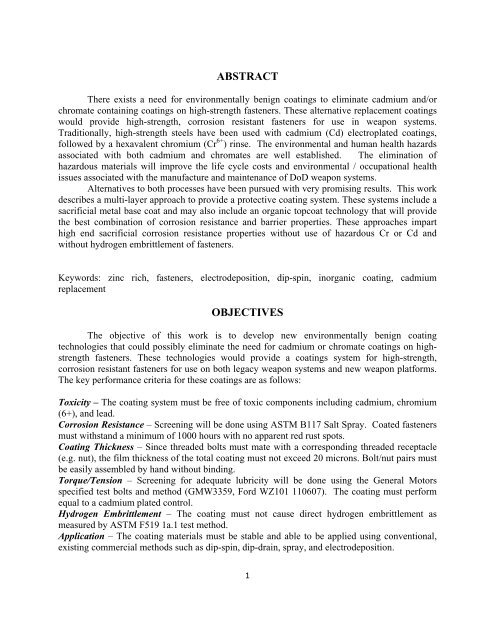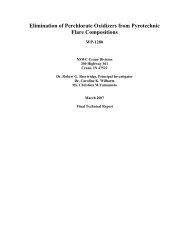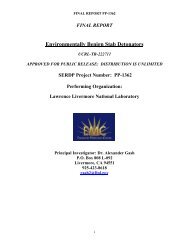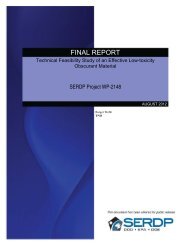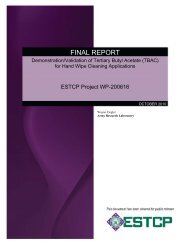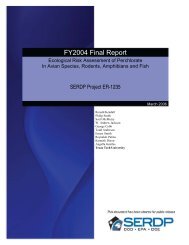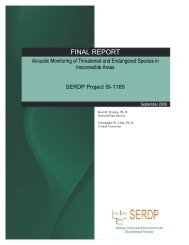Final Report - Strategic Environmental Research and Development ...
Final Report - Strategic Environmental Research and Development ...
Final Report - Strategic Environmental Research and Development ...
You also want an ePaper? Increase the reach of your titles
YUMPU automatically turns print PDFs into web optimized ePapers that Google loves.
ABSTRACT<br />
There exists a need for environmentally benign coatings to eliminate cadmium <strong>and</strong>/or<br />
chromate containing coatings on high-strength fasteners. These alternative replacement coatings<br />
would provide high-strength, corrosion resistant fasteners for use in weapon systems.<br />
Traditionally, high-strength steels have been used with cadmium (Cd) electroplated coatings,<br />
followed by a hexavalent chromium (Cr 6+ ) rinse. The environmental <strong>and</strong> human health hazards<br />
associated with both cadmium <strong>and</strong> chromates are well established. The elimination of<br />
hazardous materials will improve the life cycle costs <strong>and</strong> environmental / occupational health<br />
issues associated with the manufacture <strong>and</strong> maintenance of DoD weapon systems.<br />
Alternatives to both processes have been pursued with very promising results. This work<br />
describes a multi-layer approach to provide a protective coating system. These systems include a<br />
sacrificial metal base coat <strong>and</strong> may also include an organic topcoat technology that will provide<br />
the best combination of corrosion resistance <strong>and</strong> barrier properties. These approaches impart<br />
high end sacrificial corrosion resistance properties without use of hazardous Cr or Cd <strong>and</strong><br />
without hydrogen embrittlement of fasteners.<br />
Keywords: zinc rich, fasteners, electrodeposition, dip-spin, inorganic coating, cadmium<br />
replacement<br />
OBJECTIVES<br />
The objective of this work is to develop new environmentally benign coating<br />
technologies that could possibly eliminate the need for cadmium or chromate coatings on highstrength<br />
fasteners. These technologies would provide a coatings system for high-strength,<br />
corrosion resistant fasteners for use on both legacy weapon systems <strong>and</strong> new weapon platforms.<br />
The key performance criteria for these coatings are as follows:<br />
Toxicity – The coating system must be free of toxic components including cadmium, chromium<br />
(6+), <strong>and</strong> lead.<br />
Corrosion Resistance – Screening will be done using ASTM B117 Salt Spray. Coated fasteners<br />
must withst<strong>and</strong> a minimum of 1000 hours with no apparent red rust spots.<br />
Coating Thickness – Since threaded bolts must mate with a corresponding threaded receptacle<br />
(e.g. nut), the film thickness of the total coating must not exceed 20 microns. Bolt/nut pairs must<br />
be easily assembled by h<strong>and</strong> without binding.<br />
Torque/Tension – Screening for adequate lubricity will be done using the General Motors<br />
specified test bolts <strong>and</strong> method (GMW3359, Ford WZ101 110607). The coating must perform<br />
equal to a cadmium plated control.<br />
Hydrogen Embrittlement – The coating must not cause direct hydrogen embrittlement as<br />
measured by ASTM F519 1a.1 test method.<br />
Application – The coating materials must be stable <strong>and</strong> able to be applied using conventional,<br />
existing commercial methods such as dip-spin, dip-drain, spray, <strong>and</strong> electrodeposition.<br />
1


